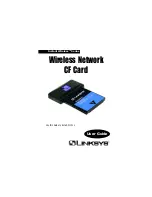
What is Ad-Hoc?
An Ad-Hoc wireless LAN is a group of computers, each with a WLAN card
connected as an independent wireless LAN. Ad hoc wireless LAN is applica-
ble at a departmental scale for a branch or SOHO operation.
What is Infrastructure?
An integrated wireless and wired LAN is called an Infrastructure configura-
tion. Infrastructure is applicable to enterprise scale for wireless access to cen-
tral database, or wireless application for mobile workers.
What is Roaming?
Roaming is the ability of a portable computer user to communicate continu-
ously while moving freely throughout an area greater than that covered by a sin-
gle Access Point. Before using the roaming function, the workstation must
make sure that it is the same channel number with the Access Point of dedicat-
ed coverage area.
To achieve true seamless connectivity, the wireless LAN must incorporate a
number of different functions. Each node and Access Point, for example, must
always acknowledge receipt of each message. Each node must maintain contact
with the wireless network even when not actually transmitting data. Achieving
these functions simultaneously requires a dynamic RF networking technology
that links Access Points and nodes. In such a system, the user’s end node under-
takes a search for the best possible access to the system. First, it evaluates such
factors as signal strength and quality, as well as the message load currently
being carried by each Access Point and the distance of each Access Point to the
wired backbone. Based on that information, the node next selects the right
Access Point and registers its address. Communications between end node and
host computer can then be transmitted up and down the backbone.
As the user moves on, the end nodes RF transmitter regularly checks the sys-
tem to determine whether it is in touch with the original Access Point or
whether it should seek a new one. When a node no longer receives acknowl-
edgment from its original Access Point, it undertakes a new search. Upon find-
ing a new Access Point, it then reregisters, and the communication process con-
tinues.
What is BSS ID?
A specific Ad hoc LAN is called a Basic Service Set (BSS). Computers in a
BSS must be configured with the same BSS ID.
19
18
Wireless Network CF Card
Troubleshooting
This chapter provides solutions to problems usually occurring during the instal-
lation and operation of the Network CF Card. Read the description below to
solve your problems. If you can’t find an answer here, check the Linksys web-
site at www.linksys.com.
1. My PDA does not recognize the Wireless CF Network Card.
• Make sure that the Network CF Card is properly inserted into the
CompactFlash port.
• Make sure the link led is solid.
2. The Wireless CF Network Card does not work properly.
• Reinsert the Network CF Card into the PDA's CompactFlash port.
• Uninstall the driver software from your PC and PDA device.
• Restart your PC and repeat the hardware and software installation as speci-
fied in this User Guide.
3. I cannot communicate with the Access Point via Ethernet in the
Infrastructure configuration.
• Make sure that the Access Point is powered on.
• Make sure that your Network CF Card is configured on the same channel,
SSID, and WEP as the Access Point.
What is IEEE 802.11b standard?
The IEEE 802.11b Wireless LAN standards subcommittee, which is formulat-
ing a standard for the industry. The objective is to enable wireless LAN hard-
ware from different manufacturers to communicate.
What IEEE 802.11b features are supported?
The product supports the following IEEE 802.11b functions:
• CSMA/CA plus Acknowledge protocol
• Multi-Channel Roaming
• Automatic Rate Selection
• RTS/CTS feature
• Fragmentation
• Power Management
Common Problems and Solutions
Frequently Asked Questions
Instant Wireless
TM
Series




































